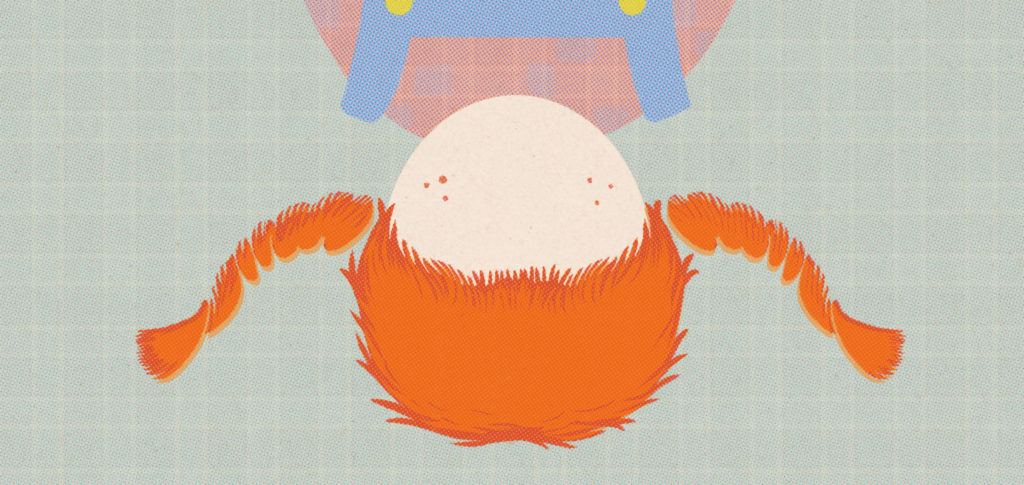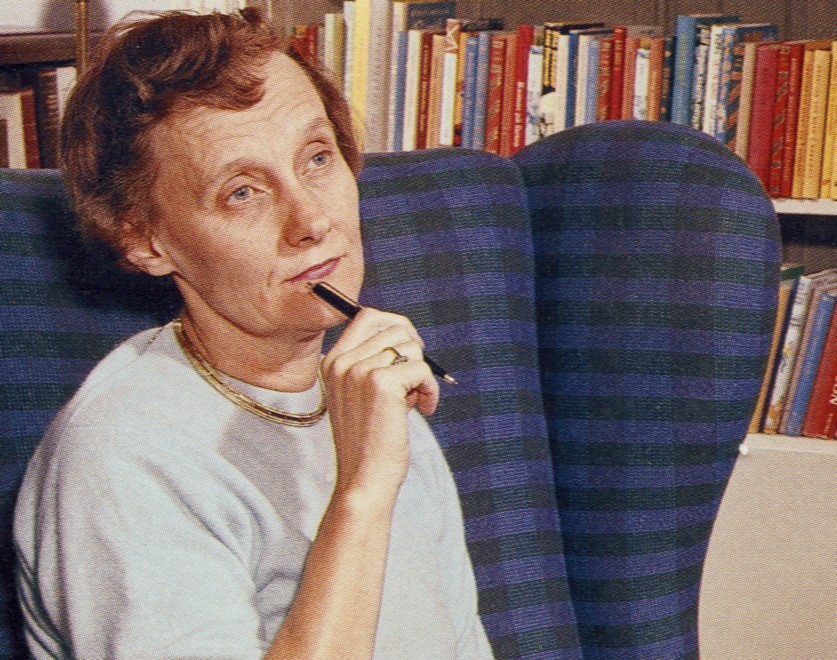In Jens Andersen’s biography, published this week in English by Yale University Press, Astrid Lindgren, the famed Swedish author of the Pippi Longstocking series, is a Walden-loving modern mind taken with loneliness. Lindgren, as Andersen notes, believed that we ought to learn to be solo artists at every stage of life. “If they’ve never learned to be alone, people develop only weak and fragile defenses against the ways life decides to hurt them,” she said. “It’s almost the most important thing of all.” Even love can barely renegotiate the fact of everyone’s self-containment, when it can at all. Lindgren writes in a letter to her best friend, “Suddenly, a person comes rushing up to you and says, ‘We’re kindred souls, we understand each other.’ And inside you hear a voice saying with painful clarity, ‘Like hell we do.’ ”
Lindgren was the eldest, dance-crazy daughter of farmers in a small town in southern Sweden. By 1924, at sixteen, she was dressing in slacks, jackets, ties, and caps and scissoring her blonde hair to boy length like the radical bachelorette in Victor Margueritte’s La garçonne (a mode Scandinavian male columnists scorned as the “Apache cut”). Her instinct for storytelling—so evident to her teachers—landed young Lindgren a gig as a trainee journalist at a local paper. There, the tomboy geared into temptress. She was not yet eighteen when her romance with the fifty-year-old married editor in chief resulted in pregnancy. “I didn’t know a scrap about contraceptive methods, so I never realized how dreadfully irresponsibly you behaved toward me,” Lindgren wrote to him later. Elsewhere she explained, “I wanted the baby but not the father.” As her belly swelled, her hometown swirled with gossip, so Lindgren left for Stockholm. “I threw myself out!” she said.
She lodged at a boardinghouse, took classes in stenography and typing, and met with a female lawyer, who helped Lindgren arrange to have her baby in Copenhagen (at a private maternity center that would issue a birth certificate without the father’s name). The son was placed in a happy foster home until Lindgren was able to recoup him three years later.
By 1941, Lindgren was married to the office manager of the Royal Automobile Club, another former boss, and had a seven-year-old daughter named Karin as well. That winter, when her daughter was laid up with pneumonia, Lindgren started telling her stories about “the strongest girl in the world.” Karin called her “Pippi.” Pippilotta Delicatessa Windowshade Mackrelmint Ephraim’s Daughter Longstocking would be just one among the gutsy loners in Lindgren’s oeuvre, but she is the character who has stuck to our ribs worldwide. The first of the three Pippi books was published in 1945 to nearly universal praise for liberating the child’s psyche. (Though one important reviewer, an alarmed Freudian, trashed the character as “psychotic.”)
Pippi is a freckly Swede, aged nine. She has Herculean strength (enough to lift a horse), carrot-colored hair, and an anarchic spirit. She plaits her hair into pigtails like handlebars and lets her spirit rip, and that is her prerogative. Pippi’s mother died when she was in infancy and her father, a ship captain, is not there. She lives by herself with a pet monkey. She cooks messily and cleans messily and does not attend school or observe a bedtime. Policemen tried to put her into foster care once, but she pulled them into a game of tag, and when two other men attempted to burglar her house, she made them dance with her. The girl drinks coffee. She has, on occasion, gobbled poisonous fungi. “Don’t you worry about me,” Pippi says. “I’ll always come out on top.”
“I don’t know how many interpretations of Pippi Longstocking I have been offered over the years,” Lindgren recounted at a Library of Congress talk in 1982. She swore she hadn’t meant anything by a kid who was not dependent, mannerly, or shrinking, but Pippi, Andersen points out, was an early baby grrrl, born to a mother-author who went against the grain of the reigning seen-and-not-heard school. Lindgren was switched on to avant-garde interwar and postbellum ideas about raising children and writing for them. The family’s flat looked out on a park, which was, as Andersen puts it, a “psychological laboratory.” Lindgren, watching the interactions between adults and children, was shocked by how the former “browbeat” and “trampled on” the later. As a mother of two, she said, “I took their side against myself.” As an author, she eschewed sermonizing, engaged the child’s internal world and used their voice, something Hans Christian Andersen—the subject of another biography by Jens Andersen—did first, about a century earlier, when Romanticism blew across Europe after the Napoleonic Wars.
Pippi Longstocking was not dear to me. In fact, I barely knew her, and not at all in book form. Sometimes, I would catch Astrid Lindgren’s Pippi Longstocking when the animated series aired on Cartoon Network in the late nineties. Pippi survived that adaptation true to text: she was obviously from the same tribe as Anne of Green Gables or Eliza in Nickelodeon’s The Wild Thornberrys. (Those girls also wore fiery hair in ropes and got around in practical boots.) Pippi shared DNA with Louisa May Alcott’s Jo March, Beverly Cleary’s Ramona Quimby, and Roald Dahl’s Matilda Wormwood—but she seemed like Mark Twain’s Huckleberry Finn or James Barrie’s Peter Pan most of all. In the original English-language edition, printed in 1950, Pippi, who is embossed in lingonberry on a milk-white cover, wears a nightgown and brandishes a rapier with one hand as she draws a pistol with the other. “I’m going to be a pirate when I grow up,” she announces in the last pages. It isn’t unfathomable to think that she could become Lisbeth Salander, the fierce young hacker from Stieg Larsson’s Millennium series, who dyed her Titian mane black. And yet, Pippi is a dove for whom violence is not an option.
Lindgred experienced World War II from the capital of a neutral country. She had started to journal in 1939, at the war’s outbreak, and her wartime diaries, published in English in 2016, blend normal household news with disturbing clips about the conflict. She had a secret job, self-described as “dirty,” as a reader in the censorship department of the Central Post Office, and sometimes, overwhelmed, heart-sorry, Lindgren rehashed the content from the thousands of letters in the pages of her diary. “But the Lindgren family’s doing great!” she noted blackly one day. They were safe and pretty well-off, dining or lunching on lobster, pâté, purple cabbage, and eggs. “I don’t think the Germans are even bothering to deny that Jews are being exterminated,” she wrote in the spring of 1944. In the midst of this, she was putting Pippi down in the shorthand she had learned in the twenties.
In the first cover letter to a major publisher Lindgren introduced her protagonist as “a little Übermensch.” It was “an inflammatory, adult, Nazified word,” as Andersen points out, and Lindgren’s impulse was to parody Hitler, Stalin, and Mussolini as overgrown bullies. The publisher rejected torch-bearing Pippi as “too advanced.” It was a smaller publishing house that snapped Pippi up, though not before they put through Lindgren’s debut book, Confessions of Britt-Marie, which also centered on an opinionated young lady. (Lindgred would later work at her publishing house as a part-time children’s-book editor.) Pippi was an instant success. In a joking tone, somewhere between discomfort with the celebrity and an I told you so, Lindgren later referred to Longstocking as a “national nuisance.”
In her native Sweden, Lindgren came to border on spiritual advisor. She was a feminist (though she never called herself such); an advocate for animals, workers, and the environment; and, come 1952, a solitary widow who would decline to remarry. Still, she always attempted to answer the piles of mail from children, parents, royals, and diplomats. She passed in 2002.
Lindgren’s own daughter was anxious about growing up—she developed an awareness that she’d need to learn to support herself, that she’d have to watch her mother slowly but surely age out of this world. Those fears became the subjects of her prayers at night, and Lindgren worked them into the conclusion of the Pippi trilogy. At the end of the third book, the heroine is sitting alone at her kitchen table; she looks fixedly at a candle flame, the same orange-red as her hair. Eventually, she blows it out. Pippi isn’t afraid of anything, not even the dark.
Chantel Tattoli is a freelance journalist. She’s contributed to the New York Times Magazine, VanityFair.com, the Los Angeles Review of Books, and Orion and is at work on a cultural biography of Copenhagen’s statue of the Little Mermaid.
Ellis Rosen, who contributed original art to this piece, is a cartoonist and illustrator living in Brooklyn, New York. His work has appeared in The New Yorker, The Paris Review Daily, and The Millions.
from The Paris Review http://ift.tt/2ozINk4


Comments
Post a Comment